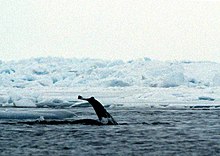Polynya
As Polynya (also Polynya , Polynia ) refers to a large open water surface or thin ice layer in the Arctic or Antarctic ice , which may reach an area of several thousand square kilometers. The term is derived from the Russian word полынья [ pʌɫɨˈɲja ], which denotes ice-free areas on any otherwise frozen body of water - including wakings on rivers and inland lakes.
Polynjas ( plural also: Polynyas, Polynjen, Polynien) are usually created by the action of wind, tides or rising warm sea water. They can often persist for long periods of time, possibly for years, and are the subject of polar research due to their influence on ocean currents , marine biology and climate . According to their place of origin, three types of polynjas are distinguished: coastal polynjas ( Coastal or Shore Polynyas ), Polynjas bounded by fixed ice ( Flaw Polynyas ), and Polynjas away from the coast ( Open-Ocean Polynyas ).
Küstenpolynjas ( Coastal or Shore polynyas )
Coastal polynjas arise when strong, offshore downdraft winds from the mainland drive newly formed ice away from the coast. This creates ice-free zones between the pack ice and the mainland ice , which can be 50 to 100 kilometers wide. Coastal polynjas are so-called “ sea ice factories”: the wind drives the sea ice away from the coast and again exposes the water to the cooling earth's atmosphere until it freezes. The resulting ice is driven away from the coast by the wind.
Polynjas bounded by fast ice ( Flaw Polynyas )
Polynjas can also be formed on fast ice. They are usually wind-induced. Here, the pack ice is by winds from the Festeisgrenze advected . This process usually takes place several times in winter in the same places in the Arctic shelf seas . One example is the polynyas occurring in the Laptev Sea off northeast Siberia . Due to the sea ice production, which makes a decisive contribution to the Arctic Ocean (the sea ice formed in the Polynjas is transported to the Arctic Ocean with the transpolar drift ), they are the subject of many research projects.
Polynyas far from the coast ( open ocean polynyas )
So-called open ocean polynyas develop far from the coast . Presumably, they arise from the fact that warmer deep water is deflected towards the surface by elevations in the sea floor ( seamounts , even at great depths) and the ice melts from below. The best-known offshore polynya in the Southern Ocean was the Weddell polynya, which formed in the Weddell Sea in three consecutive years (1974-1976) and whose largest extension was about 1000 by 350 kilometers. In 2017, the return of the Weddell polynya was proven by studies by GEOMAR Kiel. Polynya of comparable size and distance from the coast have not been observed in the Arctic Ocean for a long time; in August 2006, however, a large polynya formed in the Beaufort Sea .
Impact and Importance
Polynjas play a significant role in the formation of cold, dense Antarctic bottom water (AABW), which is the lowest water layer in all oceans. The cooling of the water and the constant formation of sea ice - which contains very little salt - creates a very cold, salty and therefore dense water that sinks to great depths.
In Polynjas the phenomenon of "Arctic sea smoke" can often be observed, which rises from the open water into the much colder ambient air. This is a sign that a lot of heat is being given off from the sea into the atmosphere.
In addition to the formation of deep water, polynjas are of great importance for the organisms found in the Antarctic and Arctic. Holes in the ice are essential for mammals like seals and whales , who need air to breathe. In addition, microscopic algae ( phytoplankton ) can grow better here than under the ice, as there is more light (in the polar summer). Small crabs ( krill , Euphausia superba ) feed on phytoplankton , which in turn represent the main food for whales and other animals.
Theory of the ice-free Arctic Ocean
The observations of Polynjas by the polar explorers Elisha Kent Kane , Isaac Israel Hayes and George De Long may have been the reason why scientists believed in an ice-free zone around the North Pole in the mid-19th century. It was not until the Austro-Hungarian North Pole Expedition 1872–1874 and an expedition by George Nares (1872–1876) that this thesis was clearly refuted.
See also
- Antarctic bottom water
- Consequences of global warming in Antarctica
- Consequences of global warming in the Arctic
- North water
literature
- Igor Appel: Polynyas . In: Mark Nuttall (Ed.): Encyclopedia of the Arctic . Routledge, New York and London 2003, ISBN 1-57958-436-5 , pp. 1678–1680 (English, limited preview in Google Book Search).
Web links
- Report of a Polynja expedition, Radio Bremen ( Memento from September 30, 2007 in the Internet Archive )
- Thomas Ernsdorf: Simulation of the dynamics of the Laptev Sea Polynjen with the sea ice-ocean model FESOM using in-situ data and global analyzes. Diploma thesis at the University of Trier, Department VI - Geography / Geosciences, Environmental Meteorology, 105 pp., 2009 (PDF; 10.8 MB)
- Timmermann, R .: Formation and conservation of a polynja in the Weddell Sea. Diploma thesis Univ. Bremen, 1996 (PDF; 3.8 MB) ( Memento from September 27, 2007 in the Internet Archive )
- Polynjas in the sea ice portal of the Alfred Wegener Institute


